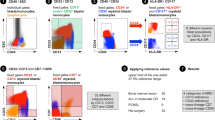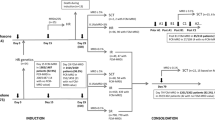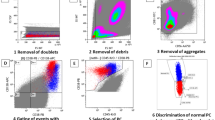Abstract
Minimal residual disease (MRD) is an independent prognostic factor in childhood acute lymphoblastic leukemia (ALL). The most widely applied MRD assays in ALL are flow cytometric identification of leukemia immunophenotypes and polymerase chain reaction (PCR) amplification of antigen-receptor genes. We measured MRD by both assays in 227 patients with childhood B-lineage ALL. Of 1375 samples (736 bone marrow and 639 peripheral blood) examined, MRD was <0.01% in 1200, and ⩾0.01% in 129 by both assays; MRD levels measured by the two methods correlated well. Of the remaining 46 samples, 28 had MRD ⩾0.01% by flow cytometry but <0.01% by PCR. However, PCR (which had a consistent sensitivity of 0.001%) detected leukemic gene rearrangements in 26 of these 28 samples. Conversely, in 18 samples, MRD was ⩾0.01% by PCR but <0.01% by flow cytometry. In nine of these samples, flow cytometry had a sensitivity of 0.001%, and detected aberrant immunophenotypes in eight samples. Therefore, the two most widely used methods for MRD detection in ALL yield concordant results in the vast majority of cases, although the estimated levels of MRD may vary in some. The use of the two methods in tandem ensures MRD monitoring in all patients.
This is a preview of subscription content, access via your institution
Access options
Subscribe to this journal
Receive 12 print issues and online access
$259.00 per year
only $21.58 per issue
Buy this article
- Purchase on Springer Link
- Instant access to full article PDF
Prices may be subject to local taxes which are calculated during checkout


Similar content being viewed by others
References
Brisco MJ, Condon J, Hughes E, Neoh SH, Sykes PJ, Seshadri R et al. Outcome prediction in childhood acute lymphoblastic leukaemia by molecular quantification of residual disease at the end of induction. Lancet 1994; 343: 196–200.
Coustan-Smith E, Behm FG, Sanchez J, Boyett JM, Hancock ML, Raimondi SC et al. Immunological detection of minimal residual disease in children with acute lymphoblastic leukaemia. Lancet 1998; 351: 550–554.
Cave H, van der Werff ten Bosch J, Suciu S, Guidal C, Waterkeyn C, Otten J et al. Clinical significance of minimal residual disease in childhood acute lymphoblastic leukemia. European Organization for Research and Treatment of Cancer – Childhood Leukemia Cooperative Group. N Engl J Med 1998; 339: 591–598.
van Dongen JJ, Seriu T, Panzer-Grumayer ER, Biondi A, Pongers-Willemse MJ, Corral L et al. Prognostic value of minimal residual disease in acute lymphoblastic leukaemia in childhood. Lancet 1998; 352: 1731–1738.
Coustan-Smith E, Sancho J, Hancock ML, Boyett JM, Behm FG, Raimondi SC et al. Clinical importance of minimal residual disease in childhood acute lymphoblastic leukemia. Blood 2000; 96: 2691–2696.
Nyvold C, Madsen HO, Ryder LP, Seyfarth J, Svejgaard A, Clausen N et al. Precise quantification of minimal residual disease at day 29 allows identification of children with acute lymphoblastic leukemia and an excellent outcome. Blood 2002; 99: 1253–1258.
Panzer-Grumayer ER, Schneider M, Panzer S, Fasching K, Gadner H . Rapid molecular response during early induction chemotherapy predicts a good outcome in childhood acute lymphoblastic leukemia. Blood 2000; 95: 790–794.
Dworzak MN, Froschl G, Printz D, Mann G, Potschger U, Muhlegger N et al. Prognostic significance and modalities of flow cytometric minimal residual disease detection in childhood acute lymphoblastic leukemia. Blood 2002; 99: 1952–1958.
Coustan-Smith E, Sancho J, Hancock ML, Razzouk BI, Ribeiro RC, Rivera GK et al. Use of peripheral blood instead of bone marrow to monitor residual disease in children with acute lymphoblastic leukemia. Blood 2002; 100: 2399–2402.
Coustan-Smith E, Sancho J, Behm FG, Hancock ML, Razzouk BI, Ribeiro RC et al. Prognostic importance of measuring early clearance of leukemic cells by flow cytometry in childhood acute lymphoblastic leukemia. Blood 2002; 100: 52–58.
Coustan-Smith E, Gajjar A, Hijiya N, Razzouk BI, Ribeiro RC, Rivera GK et al. Clinical significance of minimal residual disease in childhood acute lymphoblastic leukemia after first relapse. Leukemia 2004; 18: 499–504.
Pui CH, Campana D . New definition of remission in childhood acute lymphoblastic leukemia. Leukemia 2000; 14: 783–785.
Gadner H, Haas OA, Masera G, Pui CH, Schrappe M . Ponte di Legno’ Working Group – report on the Fifth International Childhood Acute Lymphoblastic Leukemia Workshop: Vienna, Austria, 29 April–May 2002. Leukemia 2003; 17: 798–803.
Knechtli CJC, Goulden NJ, Hancock JP, Grandage VLG, Harris EL, Garland RJ et al. Minimal residual disease status before allogeneic bone marrow transplantation is an important determinant of successful outcome for children and adolescents with acute lymphoblastic leukemia. Blood 1998; 92: 4072–4079.
Knechtli CJ, Goulden NJ, Hancock JP, Harris EL, Garland RJ, Jones CG et al. Minimal residual disease status as a predictor of relapse after allogeneic bone marrow transplantation for children with acute lymphoblastic leukaemia. Br J Haematol 1998; 102: 860–871.
Bader P, Hancock J, Kreyenberg H, Goulden NJ, Niethammer D, Oakhill A et al. Minimal residual disease (MRD) status prior to allogeneic stem cell transplantation is a powerful predictor for post-transplant outcome in children with ALL. Leukemia 2002; 16: 1668–1672.
Goulden N, Bader P, van der Velden V, Moppett J, Schilham M, Masden HO et al. Minimal residual disease prior to stem cell transplant for childhood acute lymphoblastic leukaemia. Br J Haematol 2003; 122: 24–29.
Campana D . Determination of minimal residual disease in leukemia patients. Br J Haematol 2003; 121: 823–838.
Szczepanski T, Orfao A, van derVelden VH, San Miguel JF, van Dongen JJ . Minimal residual disease in leukaemia patients. Lancet Oncol 2001; 2: 409–417.
Foroni L, Harrison CJ, Hoffbrand AV, Potter MN . Investigation of minimal residual disease in childhood and adult acute lymphoblastic leukaemia by molecular analysis. Br J Haematol 1999; 105: 7–24.
Pongers-Willemse MJ, Seriu T, Stolz F, d’Aniello E, Gameiro P, Pisa P et al. Primers and protocols for standardized detection of minimal residual disease in acute lymphoblastic leukemia using immunoglobulin and T cell receptor gene rearrangements and TAL1 deletions as PCR targets. Leukemia 1999; 13: 110–118.
Campana D, Coustan-Smith E . Advances in the immunological monitoring of childhood acute lymphoblastic leukaemia. Best Pract Res Clin Haematol 2002; 15: 1–19.
Neale GA, Coustan-Smith E, Pan Q, Chen X, Gruhn B, Stow P et al. Tandem application of flow cytometry and polymerase chain reaction for comprehensive detection of minimal residual disease in childhood acute lymphoblastic leukemia. Leukemia 1999; 13: 1221–1226.
Malec M, Bjorklund E, Soderhall S, Mazur J, Sjogren AM, Pisa P et al. Flow cytometry and allele-specific oligonucleotide PCR are equally effective in detection of minimal residual disease in ALL. Leukemia 2001; 15: 716–727.
Coustan-Smith E, Ribeiro RC, Rubnitz JE, Razzouk BI, Pui CH, Pounds S et al. Clinical significance of residual disease during treatment in childhood acute myeloid leukemia. Br J Haematol 2003; 123: 243–252.
Aubin J, Davi F, Nguyen-Salomon F, Leboeuf D, Debert C, Taher M et al. Description of a novel FR1 IgH PCR strategy and its comparison with three other strategies for the detection of clonality in B cell malignancies. Leukemia 1995; 9: 471–479.
Ramasamy I, Brisco M, Morley A . Improved PCR method for detecting monoclonal immunoglobulin heavy chain rearrangement in B cell neoplasms. J Clin Pathol 1992; 45: 770–775.
Deane M, Norton JD . Immunoglobulin heavy chain variable region family usage is independent of tumor cell phenotype in human B lineage leukemias. Eur J Immunol 1990; 20: 2209–2217.
Gruhn B, Hongeng S, Yi H, Hancock ML, Rubnitz JE, Neale GA et al. Minimal residual disease after intensive induction therapy in childhood acute lymphoblastic leukemia predicts outcome. Leukemia 1998; 12: 675–681.
Taswell C . Limiting dilution assays for the determination of immunocompetent cell frequencies. I. Data analysis. J Immunol 1981; 126: 1614–1619.
Sykes PJ, Neoh SH, Brisco MJ, Hughes E, Condon J, Morley AA . Quantitation of targets for PCR by use of limiting dilution. Biotechniques 1992; 13: 444–449.
Ouspenskaia MV, Johnston DA, Roberts WM, Estrov Z, Zipf TF . Accurate quantitation of residual B-precursor acute lymphoblastic leukemia by limiting dilution and a PCR-based detection system: a description of the method and the principles involved. Leukemia 1995; 9: 321–328.
Pongers-Willemse MJ, Verhagen OJ, Tibbe GJ, Wijkhuijs AJ, de Haas V, Roovers E et al. Real-time quantitative PCR for the detection of minimal residual disease in acute lymphoblastic leukemia using junctional region specific TaqMan probes. Leukemia 1998; 12: 2006–2014.
Chen X, Pan Q, Stow P, Behm FG, Goorha R, Pui CH et al. Quantification of minimal residual disease in T-lineage acute lymphoblastic leukemia with the TAL-1 deletion using a standardized real-time PCR assay. Leukemia 2001; 15: 166–170.
Campana D, Coustan-Smith E . Detection of minimal residual disease in acute leukemia by flow cytometry. Cytometry 1999; 38: 139–152.
Beishuizen A, Verhoeven MA, Van Wering ER, Hahlen K, Hooijkaas H, van Dongen JJ . Analysis of Ig and T-cell receptor genes in 40 childhood acute lymphoblastic leukemias at diagnosis and subsequent relapse: implications for the detection of minimal residual disease by polymerase chain reaction analysis. Blood 1994; 83: 2238–2247.
Steward CG, Goulden NJ, Katz F, Baines D, Martin PG, Langlands K et al. A polymerase chain reaction study of the stability of Ig heavy-chain and T-cell receptor delta gene rearrangements between presentation and relapse of childhood B-lineage acute lymphoblastic leukemia. Blood 1994; 83: 1355–1362.
Baruchel A, Cayuela JM, MacIntyre E, Berger R, Sigaux F . Assessment of clonal evolution at Ig/TCR loci in acute lymphoblastic leukaemia by single-strand conformation polymorphism studies and highly resolutive PCR derived methods: implication for a general strategy of minimal residual disease detection. Br J Haematol 1995; 90: 85–93.
Steenbergen EJ, Verhagen OJ, van den Berg H, van Leeuwen EF, Behrendt H, Slater RR et al. Rearrangement status of the malignant cell determines type of secondary IgH rearrangement (V-replacement or V to DJ joining) in childhood B precursor acute lymphoblastic leukemia. Leukemia 1997; 11: 1258–1265.
Szczepanski T, Willemse MJ, Brinkhof B, Van Wering ER, van der BM, van Dongen JJ . Comparative analysis of Ig and TCR gene rearrangements at diagnosis and at relapse of childhood precursor-B-ALL provides improved strategies for selection of stable PCR targets for monitoring of minimal residual disease. Blood 2002; 99: 2315–2323.
Li A, Zhou J, Zuckerman D, Rue M, Dalton V, Lyons C et al. Sequence analysis of clonal immunoglobulin and T-cell receptor gene rearrangements in children with acute lymphoblastic leukemia at diagnosis and at relapse: implications for pathogenesis and for the clinical utility of PCR-based methods of minimal residual disease detection. Blood 2003; 102: 4520–4526.
Acknowledgements
We thank Chris Clark, Peixin Liu, Mo Mehrpooya and Laura Woodruff for excellent technical assistance with MRD studies, and the physicians and nurses of St Jude Children's Research Hospital for continuing support. This work was supported by Grants CA52259, CA60419, and CA21765 from the National Cancer Institute, and by the American Lebanese Syrian Associated Charities (ALSAC). Ching-Hon Pui is the FM Kirby Clinical Research Professor of the American Cancer Society.
Author information
Authors and Affiliations
Corresponding author
Rights and permissions
About this article
Cite this article
Neale, G., Coustan-Smith, E., Stow, P. et al. Comparative analysis of flow cytometry and polymerase chain reaction for the detection of minimal residual disease in childhood acute lymphoblastic leukemia. Leukemia 18, 934–938 (2004). https://doi.org/10.1038/sj.leu.2403348
Received:
Accepted:
Published:
Issue Date:
DOI: https://doi.org/10.1038/sj.leu.2403348
Keywords
This article is cited by
-
Prescreening of tumor samples for tumor-centric transcriptome analyses of lung adenocarcinoma
BMC Cancer (2022)
-
Value of flow cytometry for MRD-based relapse prediction in B-cell precursor ALL in a multicenter setting
Leukemia (2021)
-
Flow Cytometric Minimal Residual Disease Analysis in Acute Leukemia: Current Status
Indian Journal of Hematology and Blood Transfusion (2020)
-
Minimal residual disease quantification by flow cytometry provides reliable risk stratification in T-cell acute lymphoblastic leukemia
Leukemia (2019)
-
Clinical impact of minimal residual disease in children with different subtypes of acute lymphoblastic leukemia treated with Response-Adapted therapy
Leukemia (2017)



